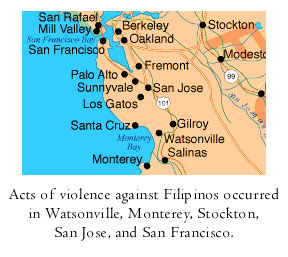Racial
Riots
Because
of jealousy and hatred of the Filipinos, Caucasian
Americans precipitated racial violence. The
first race riot occurred in Exeter, California,
on the night of October 24, 1929 after the Americans
were displaced by Filipinos in harvesting Kadota
figs and Emperor grapes. A mob of 300 men stormed
a Filipino camp, stoned and clubbed about 50
Filipinos, and burned the barn. About 200 Filipinos
were driven out of the district.
 The
most explosive riot occurred in Watsonville
where Filipinos had been constantly harassed.
The Northern Monterey Chamber of Commerce adopted
anti-Filipino resolutions. On January 11, 1930,
a small Filipino club leased a dance hall from
two Americans in Palm Beach. The thought of
Filipinos dancing with white women angered Watsonville
citizens. On January 20, 1930, about 200 Americans
hunted Filipinos on the streets, and on the
following day, the dance hall was raided. Two
days later, Filipinos were beaten and one was
killed by a mob of 500 white Americans who also
destroyed the Filipino quarters.
The
most explosive riot occurred in Watsonville
where Filipinos had been constantly harassed.
The Northern Monterey Chamber of Commerce adopted
anti-Filipino resolutions. On January 11, 1930,
a small Filipino club leased a dance hall from
two Americans in Palm Beach. The thought of
Filipinos dancing with white women angered Watsonville
citizens. On January 20, 1930, about 200 Americans
hunted Filipinos on the streets, and on the
following day, the dance hall was raided. Two
days later, Filipinos were beaten and one was
killed by a mob of 500 white Americans who also
destroyed the Filipino quarters.
On
January 28, 1930, a Filipino clubhouse in Stockton
was dynamited. In August, 1930, a bundle of
dynamite was also thrown in the camp of 100
sleeping Filipinos near Reedley in protest over
the presence of 500 Filipinos in the region.
The whites were angered by alleged undercutting
of wages committed by the Filipinos.
Minor
riots and clashes occurred in Filipino communities
in San Jose and San Francisco. The Filipinos
were attacked after they took over the jobs
of the Americans. The Filipino presence was
blamed for the decline of wages of fig, lettuce,
and asparagus harvesters.
For
several years, lobby groups in California led
by American laborers had lobbied to bar Filipinos
from the U.S., which was similar to the exclusion
policy against the Chinese and Japanese. In
1929, the California legislature passed a resolution
calling for a congressional enactment to restrict
Filipino immigration. Together with exclusion,
there were persistent calls for the repatriation
of the Filipinos. The Great Depression exacerbated
race relations and provided more compelling
reasons to restrict Filipino migration. In 1935,
the U.S Congress passed the Repatriation Act
calling for Filipino repatriation. Most of the
Filipinos preferred to remain in California
than be repatriated, and only 2,190 Filipinos
ended up returning home to the Philippines.

